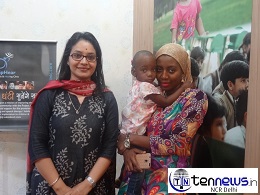2 Year-Old #Tanzanian Child Gets Gift of Hearing in #India


2 Year-Old Tanzanian Child Gets Gift of Hearing in India
- The family’s search for the best treatment for their congenitally deaf child brought them to India
- The girl will remain in touch with the clinic in India for at least two years for speech & hearing training with the help of an IT backed distance mapping and training program
New Delhi, 5 March 2016: At 2.5 years of age, Nadia Juma has only just started responding to sounds! Thanks to the advanced treatment for congenital deafness she has undergone in India, the little girl from Tanzania can now lead a productive life like normal children.
Back at home, the family of the child had noticed her lack of response to sounds much earlier. Medical diagnosis revealed that the girl was congenitally deaf and needed advanced treatment mechanism and solutions like cochlear implants to be able to hear and speak.
Determined that she wanted her daughter to grow up and learn like normal children, her mother launched a search for medical destinations that could give her child the best and highly advanced medical treatment. The search then led to India where they met senior ENT & Cochlear Implant Surgeon Dr Ameet Kishore.
Apart from Dr Kishore, the family met Senior Audiologist & Founder of Sphear Speech & Hearing Clinic Ms Neevita Narayan and a team of Speech and Hearing therapists for a series of and hearing tests to confirm the diagnosis and plan the management.
“A substantial number of patients from African countries visit us in their search for the best hearing and speech solutions. Like most patients, they want to be treated by highly experienced doctors and experts and they are confident of the services provided in India. Nadia Juma’s family was one such family that was desperate for the best possible hearing solution for their child. Such a diagnosis is never easy on parents but Nadia’s family was aware of the importance of early intervention and did not want to waste time. Their search for the best cochlear implant service led them to us,” says Ms Neevita Narayan, Senior Audiologist & Founder of Sphear Speech & Hearing Clinics.
After a thorough examination, the Sphear team concluded that the girl was a candidate for bilateral cochlear implantation implying that the cochlear device was needed in both her hears. The mother was aware of the importance of hearing from both ears as early as possible as this will ensure the best result for her child in terms of speech and language development.
“For children who are deaf in both ears, it is important to implant and set in motion cochlear devices in both hears simultaneously as it prevents the complexity of two surgical procedures and the need to activate the devices at different points of time. When implants in both ears start functioning at the same time, this gives the best result in terms of hearing and speech learning of the child. Nadia underwent bilateral simultaneous cochlear implantation at Indraprastha Apollo Hospital. In a single operation, I implanted the cochlear implants in both her ears. We used the latest generation devices of cochlear implants called Nucleus Freedom N6 which are the best available technology in the arena today,” says Dr Ameet Kishore, ENT & Cochlear Implant Surgeon at Indraprastha Apollo Hospital & Sphear Speech & Hearing Clinic.
Following the surgery, the child’s cochlear implants were activated at SpHear Clinic and to the delight of her mother she has already started responding to sounds for the first time in her life. She will continue to receive speech therapy and mapping of her devices at SpHear Clinic for a couple of months before she returns home.
However, the treatment for hearing impairment does not end at activating the implants. Rather, a long process of training and equipping the child to hear and make sense of the sounds has just begun. Though the family is set to return to Tanzania in two months, they will need to remain in constant touch with the speech and hearing therapists at Sphear. This will be made possible with SpHear clinic’s programme of distance mapping and training using technology such as Skype and remote mapping to support out station recipients of cochlear implants.
“We have a regular program of supporting outstation patients through the use of IT and remote mapping. A large number of our patients get continuous speech and hearing therapy for months through digital mechanisms like video chatting and training programs. Also, before the family leaves we are providing extensive training to the mother to empower her to teach her child to listen and give meaning to the sounds she hears,” says Ms Neevita Narayan.
While the child has begun to respond to sound, it will take her some time to be able to hear well and speak like other children. Hearing and speech therapy as well as regular mapping will help achieve that.
